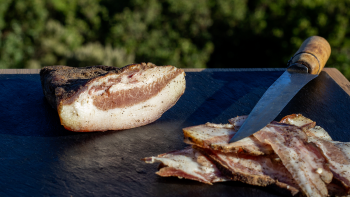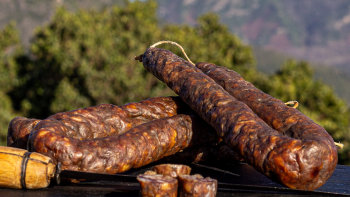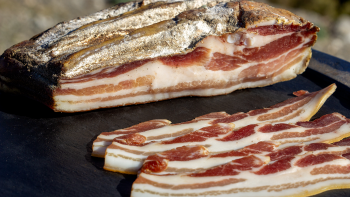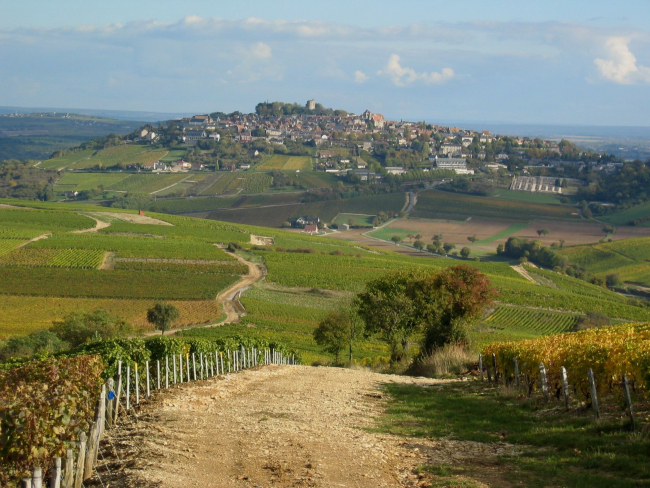This article is older and has been archived.
It remains accessible, but the information provided may be out of date or incorrect.
Defense and management organization
Four PGI charcuterie products: Bulagna, Figatelli, Pancetta and Saucisson sec de l'Île de Beauté [ODG].
Bulagna, Figatelli, Pancetta and Saucisson sec de l'Île de Beauté are flagship products of traditional know-how, processed in the two départements of Corse-du-Sud and Haute-Corse. These four products are now recognized as Protected Geographical Indications (PGI) following their registration by the European Commission on July 26, 2023. They now enjoy Europe-wide protection. This recognition enhances the charcuterie practices developed by Corsican producers.
The"Bulagna de l'Île de Beauté" is made from pork belly salted with dry salt, smoked and then matured. Its typically amber color (between brown and golden) is linked to the smoking process. With its firm, melting texture, it has a strong aroma, first of all smoky and peppery, then of dried, matured meat. On the palate, its peppery flavor and persistent smokiness are noteworthy. Bulagna is usually prepared in slices for frying with eggs, but can also replace lardons in various recipes. It is marketed whole as a triangle, in portions or sliced.


The "Figatelli de l'Île de Beauté" or "Figatellu de l'Île de Beauté" is a U-shaped raw pork liver sausage for cooking, obtained by grinding meat, offal and pork fat, all expertly seasoned. It takes its name from "fegatu" meaning liver in Corsican. It can be char-grilled, oven-roasted or pan-fried.
"Pancetta de l'Île de Beauté" or "Panzetta de l'Île de Beauté" is made from pork belly that has been salted, peppered, smoked and then dried. It comes flat or rolled in a natural gut. It is eaten in thin slices and usually pan-fried or barbecued.


The "Saucisson sec de l'Île de Beauté" or "Salciccia de l'Île de Beauté" is made from minced meat blending lean and fat pork. It is salted, peppered, dried and matured. It is generally enjoyed as an aperitif or starter.
Local know-how handed down from generation to generation
The production of Bulagna, Figatelli, Pancetta and dry sausage from the Isle of Beauty is distinguished by techniques handed down from generation to generation: salting with dry salt contributes to a balanced, salty flavor; for dry sausage and figatelli, coarse-grained mincing provides a heterogeneous texture to ensure firmness and mellowness in the mouth; the use of large quantities of black pepper gives the products a characteristic peppery note; smoking with local hardwoods provides a long, persistent smoky taste, a strong smoky odor and a typically amber color; finally, drying with the addition of outside air inside the dryer stabilizes and preserves the products, contributing to the development of their organoleptic characteristics: the right balance between dried meat, fat and salt.
One island, one story
Because of their insularity, the inhabitants of Corsica have developed know-how adapted to the island's climatic conditions and forest resources for the manufacture of charcuterie products. Indeed, the island's dry, windy climate has favored the development of dry curing as a method of preserving pork meat. Dry curing has always been an important part of the Corsican diet and, consequently, of its culture, just as the island's hardwoods (chestnut, oak, beech, etc.) have always been used for smoking charcuterie. It's a traditional technique that in the past was generally associated with the beech industry, which played an important role in the island's agriculture. From the beginning of the 20th century, in parallel with family production on the farm, a network of artisan charcutiers developed, heirs to traditional processing methods that they were able to perpetuate and adapt to regulatory requirements.
.
Corsican products under SIQO
- Cured meats : PDO "Coppa de Corse" or "Coppa de Corse-Coppa di Corsica", PDO "Jambon sec de Corse" or "Jambon sec de Corse-Prisuttu", PDO "Lonzo de Corse" or "Lonzo de Corse-Lonzu"
- Cheese: PDO "Brocciu Corse" or "Brocciu"
- Fruits: PGI "Clémentine de Corse" (associated with LA 03/14 Clémentine), PGI "Pomelo de Corse", PGI "Kiwi de Corse", PGI "Noisette de Cervione-Nuciola di Cervioni"
- Farina: PDO "Farine de châtaigne corse - Farina castagnina corsa"
- Condiment: PDO "Huile d'Olive de Corse" or "Huile d'Olive de Corse-Oliu di Corsica"
- Sweet groceries: PDO "Miel de Corse-Mele di Corsica"
- Wines: PDO "Vin de Corse ou Corse", PDO "Patrimonio", PDO "Muscat du Cap Corse", PDO "Ajaccio", PGI "Île de Beauté", PGI "Méditerranée"
Press release
Communiqué de presse : Quatre produits de charcuterie reconnus en IGP
CP INAO : Quatre produits de charcuterie reconnus en IGP
All news dedicated to ODGs
The INAO's Délégation territoriale Occitanie is organizing another regional meeting with local ODGs on Wednesday, June...
News
News
INAO is launching a new campaign to promote the 5 official signs of quality and origin (SIQO) to the general public...
News

News
The Val-de-Loire territorial delegation of the INAO is organizing another regional meeting with local ODGs on Tuesday...
News

News
